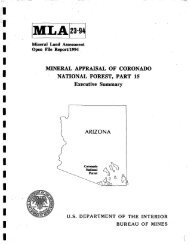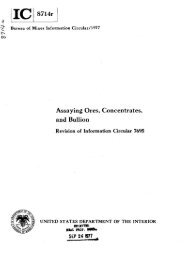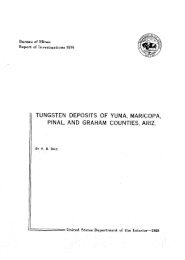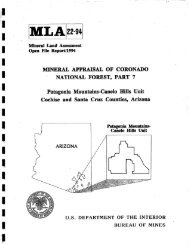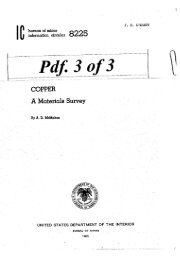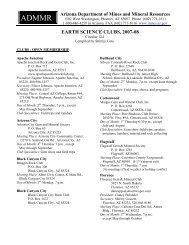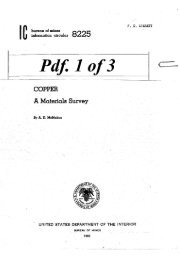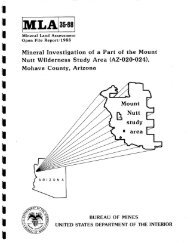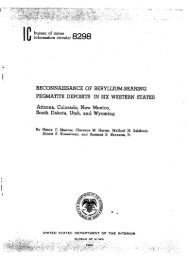USGS Professional Paper 1361 - State of Arizona Department of ...
USGS Professional Paper 1361 - State of Arizona Department of ...
USGS Professional Paper 1361 - State of Arizona Department of ...
Create successful ePaper yourself
Turn your PDF publications into a flip-book with our unique Google optimized e-Paper software.
6 GEOLOGY AND GOLD MINERALIZATION OF THE GOLD BASIN-LOST BASIN MINING DISTRICTS, ARIZONAUnconformityUnconformity8UnconformityCORRELATION OF MAP UNITSDESCRIPTION OF MAP UNITS~ Sedimentary deposits (Quaternary)-Includes sand and gravel alongactive stream washes. talus. colluvium. poorly consolidatedfanglomerate currently being dissected, and landslide deposits;also may include extensive high-level fanglomeratic deposits. west<strong>of</strong> Grand Wash Cliffs in general area <strong>of</strong> Grapevine Mesa, that maybe Tertiary and (or) Quaternary in ageIOTgIFanglomerate (Qullternary and (or) Tertiary)-Locally derivedfanglomerate deposits that include mostly clasts <strong>of</strong> metamorphicrock south-southeast <strong>of</strong> Senator Mountain and that do notcontain clasts <strong>of</strong> rapakivi granite or any interbedded tuffsMuddy Creek Formation (Tertiary)ITml I Hualapai Limestone Member-Includes limestone interbedded withthin beds <strong>of</strong> limy claystone, mudstone, and siltstone. Weatheredlimestone beds have a predominantly reddish color and form steepcliffs where they are dissected by Hualapai WashITmblIOTglUnconformityTmlTmbTmfUnconformityUnconformityI YdblUnconformity1".1"'I} I xgclIXbm11 x1ml~} I XfgI Xmg Xm0 IxmllIxgnl} Quaternary}Quaternary and(or) TertiaryTertiary} CretaceousCENOZOIC} MESOZOIC} PALEOZOICEARLYPROTEROZOICBasalt- As shown, flows at Senator Mountain. near west edge<strong>of</strong> map area. and at Iron Spring Basin, near east edge. Basalt inthese two areas correlates probably with basalt Dows (not shown)that conformably underlie the Hualapai Limestone Member andalso are interbedded with fanglomerate 01 the Muddy Creek Formationnear northwest corner <strong>of</strong> map area. Whole-rock K-Ar agedetermination <strong>of</strong> basalt from this area yields age <strong>of</strong> 10.9 Ma (seesection by E.H. McKee, this report)}MIDDLEPROTEROZOICFanglomerate-Alluvial fanglomeratic deposits that include conglomerate.sandstone. siltstone. mudstone. and locally abundantgypsum lenses. Locally includes lenses and beds <strong>of</strong> rhyolitic tuffand, as shown near southwest corner <strong>of</strong> map area. fanglomeratemapped previously by Blacet (1975) as unit n. Unit is also intrudedby minor basalt dikes, especially in general area <strong>of</strong> Senator Mountain.Near northwest corner <strong>of</strong> map area. unit includes wellexposedDows <strong>of</strong> basaltG Volcanic rocks (Tertiary)-Includes mostly andesite. Map unit nearnorthwest corner <strong>of</strong> map area internally is highly broken bynumerous faults, and near here, unit also includes air-fall tuff andreddish·brown sandstone interbedded with chaotic sedimentarybreccia composed <strong>of</strong> fragments <strong>of</strong> Early Proterozoic gneiss. Inplaces, unit also includes massive porphyritic hornblende andesiteand basalt Dows and breccia and overall minor amounts <strong>of</strong> tightlycemented volcaniclastic rocks. Flow layering and bedding gener·ally dip at angles <strong>of</strong> 35' in contrast with shallow dips <strong>of</strong> about 5'in unconformably overlying basal fanglomerate <strong>of</strong> the MuddyCreek Formation. Age ranges <strong>of</strong> 11.8 to 14.6 Ma are reported neartype section <strong>of</strong> the Mount Davis Volcanics (Anderson and others,1972), whereas K·Ar age determination on sanidlne from air-Ialltuff near Salt Creek Wash in northwestern part <strong>of</strong> area yields age<strong>of</strong> 15.4 Ma. The volcanic rocks may be equivalent <strong>of</strong> the MountDavis Volcanics or the Patsy Mine Volcanics (see section by E.H.McKee, this report).G Rhyolitic tuffaceous sedimentary rocks and fanglomerate (Tertiary)Includes well·bedded mudDows and rhyolitic tuffaceous sedlmen·tary rocks and minor amounts <strong>of</strong> fanglomerate. Crops out as steeplydipping sequence <strong>of</strong> rocks, bounded by north-striking faults, nearsouth end <strong>of</strong> Lost Basin Range. Possibly equivalent to the MountDavis VolcanicsG Fanglomerate (Tertiary)-Coarse fanglomeratic deposits that locallyinclude landslide or mudDow breccia. Overlain unconlormably byfanglomeratic deposits <strong>of</strong> the Muddy Creek Formation, and apparentlyIntercalated with andesite possibly equivalent to theMount Davis VolcanicsI Tmf IFIGURE 2.-Continued.Two·mica monzogranite (Cretaceous)-Includes mostly highlyleucocratic muscovite-biotite monzogranite and some minoramounts <strong>of</strong> felsic muscovite granodiorite and episyenitic-alteredmuscovite-biotite monzogranite. Some facies are fluorite bearing.Porphyritic variants contain as much as 5 percent quartzphenocrysts. In places, contains very weakly defined primary layering<strong>of</strong> dimensionally oriented potassium feldspar and biotite8 Sedimentary rocks, undivided (Paleozoic)-Includes Cambrian TapeatsSandstone, Bright Angel Shale, and Muav LimestoneIYdb I Diabase (Middle Proterozoic)-·Includes normally zoned laths <strong>of</strong>plagioclase set In very fine grained matrix <strong>of</strong> granules <strong>of</strong> opaquemineral(s) and clinopyroxene. Close to chilled margins <strong>of</strong> some&esh outcrops <strong>of</strong> undeformed diabase. olivine is found in concentrations<strong>of</strong> as much as 10 volume percent. Small masses <strong>of</strong> finegraineddiabase crop out sporadically in Early Proterozoic igneousand metamorphic rocks. Most extensive exposures are about 2 kmeast <strong>of</strong> Gamet Mountain. Subophitlc textures are dominant. Lowerchilled margins <strong>of</strong> some sills contain sparse hornblende and biotitemicroveinlets. Presumed to be correlative with the diabase <strong>of</strong>Sierra Ancha, Ariz., having an emplacement age <strong>of</strong> 1,150 Ma(Silver, 1963)IXpm I Porphyritic monzogranite <strong>of</strong> Garnet Mountain (Early Proterozoic)Includes conspicuous. large potassium feldspar phenocrysts, setin a Iight·pinkish-gray, coarse-grained hypidiomorphic ground·mass. Many exposures show tabular phenocrysts as much as 10cm long. Some phases are predominantly subporphyritic seriateand show an almost continual gradation in size <strong>of</strong> their euhedralpotassium feldspar phenocrysts. Most widely exposed mass cropsout in the general area <strong>of</strong> Garnet Mountain, in the southeasternpart <strong>of</strong> the area, and extends discontinuously from there to northalong the low hills leading to Grand Wash Cliffs. Dated by Wasserburgand Lanphere (1965) to be about 1,660 Ma



